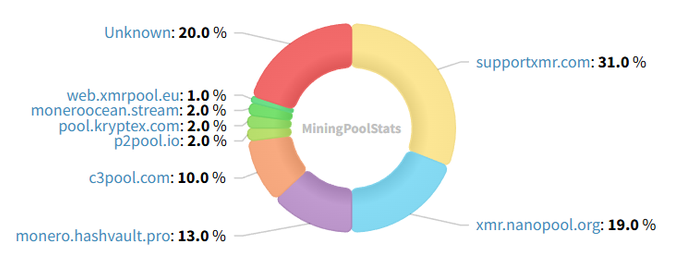Qubic initiated an “offensive” to the monero network in order to “break the bots” that steal income.
Vivancheglo explained that Qubic will make 3 mining marathons per week on the Monero Network.
In the midst of a planned offensive to achieve a majority participation in the mined power in the Monero Network, on August 3, the Qubic Mining Pool managed 20% of the blocks of that network In a period of 24 hours, as explained by Sergey Vivancheglo, founder and leader of Qubic.
As Cryptonoticia explained, that mining pool seeks to dominate the hashrate of Monero and reach 51% of the processing power in that chain during August. The intention declared by Qubic is to demonstrate the computational capacity of your network and fight the networks of Bots That, according to its founder, they currently dominate mining in Monero.
VATANCHLO detailed In X that «Qubic has finished the current Minero Minero Marathon, which lasted 24 hours. We managed to undermine 20% of the blocks despite intense attacks orchestrated by an XMRIG developer (to the Qubic network). From next Wednesday, we will have 3 marathons like this every week ».
The expression “Mining Marathon” (Mining Marathon) refers to a series of intensive tests with which Qubic tries Increase its MINERO MINING FEE. From next Wednesday, Qubic plans to make three marathons of this type every week, which could sustain or increase their participation in the network.
At the same time, Qubic leader reiterated On August 4, what was said in its publication of the previous day: the Qubic Network It is also being attacked by actors of the monero ecosystemwho would be trying to an attack of DDOS. This term refers to distributed service denial attacks, where multiple systems try to saturate a server to interrupt its operation.
VATANCHLO suggests that a developer of XMRIGMining software for Monero, “orchestrated” these ddos attacks against the Qubic network. In turn, he interprets these actions as a coordinated attempt by actors of the monoo ecosystem to stop their progress and possibly execute a 51% attack Against your own project.
It is worth remembering that Qubic involves both a mining pool in Monero, as well as its own block chain. Currently, Qubic directs part of its computational capacity to the Monero Networktaking advantage of its CPU -based architecture to obtain yields that then reinvested in your own token, Qubic.
Vivancheglo also shared a graph in which he would indicate that 20% of hashrate comes from a “unknown” source (unknown), which could include Qubic.

While Qubic holds that does not hide his computational power contributed to Moneroat the time of this publication its website does not offer such information and cannot be found in analysis tools such as Mining Pool Stats.
A campaign to displace Botnets of the Monero ecosystem
As cryptooticia notified, Qubic uses its processing capacity for monero (XMR) and then sell it by USDT. With those funds, Repurchase and burns your token qubicgenerating a deflationary circuit that potentially increases the profitability of the miners connected to the Pool Qubic.
This mechanism encouraged more users to participate in mining through Qubic, carrying their participation in the total hashrate of Monero less than 2% in May to almost 40% in July. The next step, announced by Vivancheglo, is to reach 51% of the Monero Mining Power.
The objective manifested by the Qubic leader is to “bring to bankruptcy to the owners of Bots networks that have been stealing the income of honest monero miners for years.” This was reaffirmed in a release of August 4 by the Qubic team.
Given this scenario, some members of the community proposed measures as adjustments to the Randomx algorithm, consensus changes or even a hard fork. Reaching 51% of Monero hashrate would allow, in theory, an actor to reject foreign blocks, reverse transactions or censor payments, compromising the decentralization of the network.
However, for now, concrete actions have not been defined by the maintenance equipment of the monero protocol.


